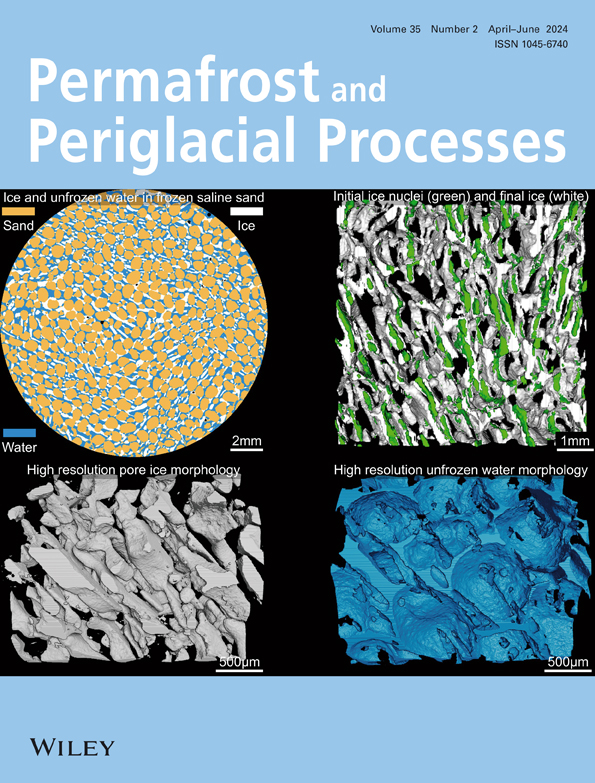Advances in retrogressive thaw slump research in permafrost regions
IF 3
3区 地球科学
Q2 GEOGRAPHY, PHYSICAL
引用次数: 1
Abstract
A retrogressive thaw slump (RTS) is a slope failure formed by slope thaw settlement and retrogressive slump following the thawing of ice‐rich permafrost or the melting of massive ice. Here, we review recent literature on RTSs, one of the main geomorphological landscapes developed in the process of permafrost degradation. The main topics are as follows: development and temporal evolution, mechanisms and processes, influencing factors, evaluation susceptibility and calculation, and assessment of engineering and environmental impacts. There has been a rapid increase in the number and distribution area of RTSs over permafrost in recent years. Climate warming events, extreme rainfall, forest fires, bank and coast erosion, and anthropogenic activity are the primary factors leading to RTSs in permafrost regions, disrupting the initial hydrothermal equilibrium of permafrost slopes. This causes a rise in ground temperature and the thaw of ice‐rich permafrost. Meltwater seeps down and collects on the ice surface, weakening freeze–thaw interface shear resistance and resulting in soil collapse. The development of RTSs may last several decades or longer. RTSs destabilize infrastructure, destroy vegetation, boost soil erosion and land desertification, alter the environment of nearby waters, and increase emissions of some major greenhouse gases. Numerous methods have been developed and adopted to explore RTSs, including geographic information systems (GIS) and equilibrium, numerical, and reliability analysis methods. However, research on formation mechanisms and processes, quantitative prediction, engineering and environmental influences, and mitigative measures of RTSs under a warming climate are still inadequate. Existing research methods, such as numerical simulations, remote sensing, airborne ground‐based geophysical surveys, investigations and mapping, and hydrothermal and deformation field monitoring, should be systematically integrated. Additionally, equipment for laboratory testing and numerical models for simulating RTSs may need to be timely introduced and better developed.永久冻土区逆行融冻坍塌研究的进展
逆退融雪坍方(RTS)是富含冰的永久冻土融化或大块冰融化后,由边坡融雪沉降和逆退坍方形成的边坡崩塌。在此,我们回顾了有关 RTS 的最新文献,RTS 是永冻土退化过程中形成的主要地貌景观之一。主要内容包括:发展和时间演变、机制和过程、影响因素、易发性评估和计算,以及工程和环境影响评估。近年来,冻土上的 RTS 数量和分布面积迅速增加。气候变暖事件、极端降雨、森林火灾、堤岸和海岸侵蚀以及人为活动是导致永久冻土地区出现 RTS 的主要因素,它们破坏了永久冻土斜坡的初始水热平衡。这导致地面温度升高,富含冰的永久冻土解冻。融水下渗并聚集在冰面上,削弱了冻融界面的抗剪能力,导致土壤塌陷。RTS 的形成可能会持续几十年或更长的时间。RTS 会破坏基础设施的稳定,破坏植被,加剧土壤侵蚀和土地荒漠化,改变附近水域的环境,并增加一些主要温室气体的排放。目前已经开发和采用了许多方法来探索 RTS,包括地理信息系统(GIS)和平衡、数值和可靠性分析方法。然而,对气候变暖条件下 RTS 的形成机理和过程、定量预测、工程和环境影响以及缓解措施的研究仍然不足。应系统地整合现有的研究方法,如数值模拟、遥感、机载地面地球物理勘测、调查和绘图以及热液和变形现场监测。此外,可能需要及时引进和更好地开发实验室测试设备和模拟 RTS 的数值模型。
本文章由计算机程序翻译,如有差异,请以英文原文为准。
求助全文
约1分钟内获得全文
求助全文
来源期刊
CiteScore
9.70
自引率
8.00%
发文量
43
审稿时长
>12 weeks
期刊介绍:
Permafrost and Periglacial Processes is an international journal dedicated to the rapid publication of scientific and technical papers concerned with earth surface cryogenic processes, landforms and sediments present in a variety of (Sub) Arctic, Antarctic and High Mountain environments. It provides an efficient vehicle of communication amongst those with an interest in the cold, non-glacial geosciences. The focus is on (1) original research based on geomorphological, hydrological, sedimentological, geotechnical and engineering aspects of these areas and (2) original research carried out upon relict features where the objective has been to reconstruct the nature of the processes and/or palaeoenvironments which gave rise to these features, as opposed to purely stratigraphical considerations. The journal also publishes short communications, reviews, discussions and book reviews. The high scientific standard, interdisciplinary character and worldwide representation of PPP are maintained by regional editorial support and a rigorous refereeing system.

 求助内容:
求助内容: 应助结果提醒方式:
应助结果提醒方式:


